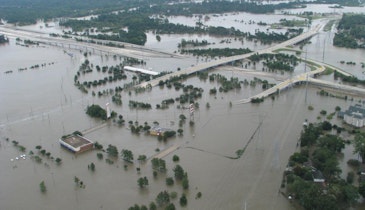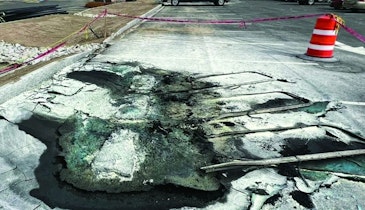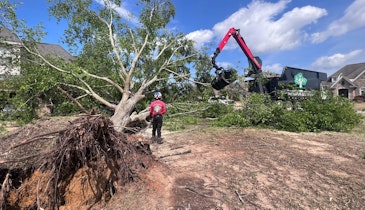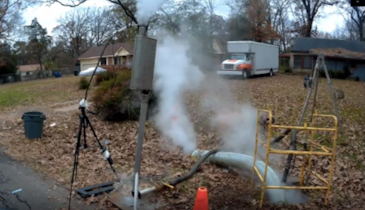
The team at Louisville includes, back row, from left, Greg Venette, water treatment superintendent; Glen Siedenburg, Matt Fromandi and Vinnie Wray, water plant operators; Ben Francisco, assistant operations superintendent; and Brian Schmid, operations technician. Front row, Trevor DePew, Chris DePalma, Thoa Pham and Jeff Owens, water plant operators; and Tom Czajka and Shane Mahan, operations technicians.
Interested in Fire?
Get Fire articles, news and videos right in your inbox! Sign up now.
Fire + Get AlertsThe Marshal Fire of December 2021 was the most destructive in the history of Colorado. The calamity might have been worse if not for the bravery of team members at the two water treatment plants in Louisville.
As it was, the wind-driven wildfire burned through subdivisions, destroying 1,084 homes in all, 550 in Louisville (pronounced Lewis-ville), 378 in neighboring Superior and 156 in unincorporated Boulder County. Total damage to those homes was $513 million. In addition, seven commercial buildings were destroyed and 30 damaged.
The fire started on the morning of Dec. 30 and burned 6,080 acres before it was extinguished with help from multiple fire departments. The suspected cause of the blaze was a coal seam fire in the area that had been smoldering for decades.
In the middle of the fight were Greg Venette, water treatment superintendent in Louisville, and his team of operators. They worked around the clock, some risking serious injury or worse, to keep water for drinking and fire suppression flowing to the two cities.
Louisville (population 21,000) and Superior (13,300) lie about 10 minutes west of Boulder in a scenic area against the Rocky Mountain foothills. Venette, a fifth-generation Colorado native who has worked for Louisville for six years, described his team’s experience in an interview.
Question: What were conditions like on the day the fire started?
Venette: Colorado had been through one of the longest periods without any snow or moisture between the fall and winter. The weather was sunny, not a cloud in the sky, but it was especially windy. The wind was peaking out at 115 mph, and it was almost knocking me and some of our staff members off our feet.
Question: What is the nature of the city’s two water plants?
Venette: We have two conventional water plants on opposite sides of town. The North Plant is the main plant with 8 mgd capacity. The South Plant was built in the 1990s with 5 mgd capacity as a peaking plant normally used only in summer.
Question: How did you and your team notice the fire?
Venette: Operators Jeff Owens and Matt Fromandi were at the South Plant doing maintenance; the plant was offline. They texted and said they saw smoke from a little grass fire west of the plant and had called 911. About 10 minutes later they let me know they were going to evacuate the plant because the smoke had gotten considerably worse. Within a few minutes the fire had just exploded and was out of control.
Question: What did you do in response to the information?
Venette: I was working from home that day. I left home about 10 minutes after they said they were evacuating. When I turned onto the highway, from about 20 miles away, it looked like a volcano had gone off. The fire was moving so fast that it passed through our South Plant site in a little over a minute and then started into some of the homes in Superior before moving into Louisville. When I got to the North Plant, operator Glen Siedenburg was already turning the plant up to full capacity.
Question: What was happening in the rest of the city?
Venette: There was a lot of chaos. We had no idea where the fire was. The smoke would shift and change with the wind. A text went out to start evacuating city facilities. Treatment plant staff made the personal decision to stay, knowing that water would be a huge factor in fighting the fire. Then I got a call that Superior’s water plant had burned down. Later I found out that what really happened is their backup generator caught on fire, taking the plant offline.
Question: With that plant offline, how was Superior supplied with water?
Venette: We have an emergency interconnect with Superior, and we had to open it. The interconnect is manually operated and is located at the South Plant. The only way to get water to Superior was to drive into the fire zone and open the interconnect. I asked operator Jeff Owens to go with me. He didn’t hesitate. We jumped into the truck and headed straight into chaos, because the entire city was evacuating.
Question: How difficult was it to get to the interconnect site?
Venette: Everywhere we went there was traffic. We circled through neighborhoods and saw large numbers of houses in flames. We drove on medians, sidewalks and ditches to get around the traffic. Eventually we arranged a police escort. Multiple trees and power lines were down in the roads. There were so many poles down on Marshall Road where the plant is that we had to cut a barbed wire fence and four-wheel across open space until we got close to the plant.
Question: What did you discover when you arrived?
Venette: We did a quick assessment and realized we had no power. With the main power down we were relying on our backup generator. Unfortunately, it’s a natural-gas-powered generator and because homes right across the street were on fire, the utility had shut the natural gas grid off. The South Plant was dead in the water. We made our way to the interconnect. The wind was brutal, and dust and ash were in the air beating on us. It was a bit like being sandblasted. Jeff and I had brought full-face respirators. We had to scream at each other to be heard through the wind and the masks.
Question: Were you able to open the interconnect?
Venette: Most of the valving is in an underground vault. Jeff stayed up top and held onto the lid so I could climb down. The wind was pushing so hard we were afraid the lid was going to close on me. I got the valves open, but there was one more gate valve we needed to operate, and it was close to the road. About 15 feet away a power pole was on fire and was burned away at the base. The poles on either side were holding it up, but it was swinging in the wind. Jeff put the key on the valve. I put my hand on his shoulder and told him that if I saw that pole coming down, we would have to run from it. We got the valve open and got out of there.
Question: How was the water supply holding up?
Venette: We checked a storage tank at the South Plant. It’s a 17-foot-deep tank that usually has 8 to 10 feet of water. It was down to one or two feet. From there we had to get back to the North Plant and make sure everything was OK, so we drove through that disaster area again. At the North Plant, the operators were all-stars. They had the plant at full capacity, pumping as much water as we could to the different zones of the distribution system to keep the supply up. We knew firefighting efforts would be huge.
Question: Did it become an all hands on deck situation?
Venette: We have eight full-time operators, and I asked them all to come if they felt it was safe. Almost all of them were available. Steven Daniels, Vinnie Wray, and Chris DePalma drove through the fire zone in their personal vehicles to get to the plant. It was pretty brave of them to do that. Next we had to get an assessment on a tank up in the highest zone of town. Jeff Owens and I arranged for a police escort. It’s a 25-foot-tall tank on top of a mesa, so you can imagine the wind force up there. In an incredible act of bravery, Jeff volunteered to climb up on the tank. He belly-crawled across the top surface to open the hatch and look inside. There was only about a foot of water left in it.
Question: What did you need to do to bolster the water supply?
Venette: I had a conversation with my boss Cory Peterson, the deputy director of utilities and Kurt Kowar, the director of public works. We decided to open the valves manually from the reservoir and run raw water through the plant and into the distribution system, so we at least had some water supply. At that point we knew we would be on boil advisory anyway because of the fire. It was incredibly difficult to make that decision, to intentionally send raw water into the system.
Question: Was the North Plant producing water effectively?
Venette: Everything was running smoothly. The guys were doing a good job keeping the plant going at high flow. Usually the high-zone pumps are pumping into the distribution system at about 110 psi. That night it was down to 70-75 psi. That’s how much water was flowing.
Question: Were you able to get the South Plant back into operation?
Venette: By about 8 p.m. the electric utility had arranged to bring natural gas tankers through the fire zone to the South Plant so we could temporarily hook up the generator. At about 11 p.m. we got the power back on, and by 5:30 the next morning we had the plant back in compliance, putting out fully treated, drinkable water.
Question: Was the water mainly being used for firefighting?
Venette: Definitely. About 10 fire companies came in. At any given point there were a dozen or more fire trucks trying to put houses out. As structures burned to the ground, their water services were destroyed and were flowing wide open, so we were essentially bleeding by 550 cuts. When we realized the magnitude and impact of this water loss, Ben Francisco, Shane Mahan, and Tom Czajka with the operations crew entered the fire zone and started shutting off curb stops, and shutting off mains where they could, working with the fire departments.
Question: Once the fire had been suppressed, what was done to return the system to normal?
Venette: We met with representatives from the state Department of Health and figured out a plan to remove the boil order. Basically, we ran the plants at a higher chlorine residual. Once that was done, distribution crews flushed the entire system from top to bottom. Crews from about a dozen cities came to help with that. They flushed the entire system in four days, which is an incredible feat. Of course we had to do a lot of sampling on the system to ensure that it was all safe. At the South Plant, we called diving crews to inspect and clean the tanks and used temporary pumping to help flush the tanks out.
Question: How did the Superior water system fare?
Venette: When we opened up the raw water through the South Plant, we closed the Superior interconnect. About the time we got the natural gas tankers in, the power company brought Superior an emergency generator so they could get their plant up and running. They started making water that night.
Question: Were there any complications after the fire?
Venette: On Jan. 1, we got a foot of snow. That complicated everything. Public Works had to plow snow, taking time away from restoring the water system and making repairs. The National Guard was called in to put a boundary around the city so that people weren’t coming into dangerous areas and to prevent unauthorized access. This also made it hard to receive deliveries and get contractors in to make repairs. It took about a week to get the South Plant back on utility power because we had to replace so much infrastructure (power line and power poles) had to be reinstalled.
Question: How would you assess the performance of your team during the emergency?
Venette: Our operators were extremely brave. They were willing to put themselves in danger to protect the community. They really went above and beyond!
This article was originally posted May 2023.





